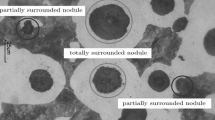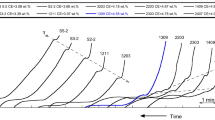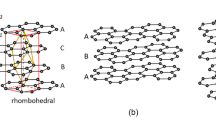Abstract
A new model of graphite growth during the continuous cooling of eutectic spheroidal cast iron is presented in this paper. The model considers the nucleation and growth of graphite from pouring to room temperature. The microstructural model of solidification accounts for the eutectic as divorced and graphite growth rate as a function of carbon gradient at the liquid in contact with the graphite. In the solid state, the microstructural model takes into account three stages for graphite growth, namely (1) from the end of solidification to the upper bound of intercritical stable eutectoid, (2) during the intercritical stable eutectoid, and (3) from the lower bound of intercritical stable eutectoid to room temperature. The micro- and macrostructural models are coupled using a sequential multiscale approach. Numerical results for graphite fraction and size distribution are compared with experimental results obtained from a cylindrical cup, in which the graphite volumetric fraction and size distribution were obtained using the Schwartz–Saltykov approach. The agreements between the experimental and numerical results for the fraction of graphite and the size distribution of spheroids reveal the importance of numerical models in the prediction of the main aspects of graphite in spheroidal cast iron.
























Similar content being viewed by others
References
ASTM A247-10: ASTM International, West Conshohocken, PA, 2010. doi:10.1520/A0247-10.
D.M. Stefanescu and C.S. Kanetkar: in Computer Simulation of Microstructural Evolution, D.J. Srolovitz, eds., TMS, Warrendale, PA, 1985, pp. 171–88.
B. C. Liu, H. D. Zhao, W. Y. Liu, and D. T. Wang: Int. J. Cast Met. Res., 1999, vol. 11(5), pp. 471-76.
S. Chang, D. Shangguan, and D. M. Stefanescu: AFS Trans., 1991, vol. 99, pp. 531-41.
S. Chang, D. Shangguan, and D. M. Stefanescu: Metall. Trans. A, 1992, vol. 23A, pp. 1333-46.
A. Almansour, K. Matsugi, T. Hatayama, and O. Yanagisawa: Mater. Trans., JIM, 1996, vol. 37(4), pp. 612–19.
D. Venugopalan: in The Physical Metallurgy of Cast Iron. Proceedings of the Fourth International Symposium on the Physical Metallurgy of Cast Iron, G. Ohira, T. Kusakawa, E. Niyama, eds., Materials Research Society, Tokyo, Japan, 1989, pp. 271–78.
D. Venugopalan: Metall. Trans. A, 1990, vol. 21A, pp. 913-18.
M. Wessen and I. L. Svensson: Metall. Trans. A, 1996, vol. 27A, pp. 2209-20.
J. Lacaze and V. Gerval: ISIJ Int., 1998, vol. 38(7), pp. 714-22.
P.M. Dardati: Ph.D. Thesis, Facultad de Ciencias Exactas Físicas y Naturales, Universidad Nacional de Córdoba, 2005.
F.D. Carazo: Ph.D. Thesis, Facultad de Ciencias Exactas Físicas y Naturales, Universidad Nacional de Córdoba, 2012.
D. Celentano, E. Oñate, and S. Oller: Int. J. Num. Meth. Eng., 1994, vol. 37, pp. 3441-65.
R. Hill: J. Mech. Phys. Solids, 1965, vol. 13(4), pp. 213-22.
F. D. Carazo, P. M. Dardati, D. J. Celentano, and L. A. Godoy: Metall. Trans. B, 2012, vol. 43(6), pp. 1579-95. doi:10.1007/s11663-012-9710-y.
B. Lux: AFS Cast Met. Res. J., 1972, vol. 8(1), pp. 25-38.
B. Lux: AFS Cast Met. Res. J., 1972, vol. 8(2), pp. 49-65.
D.M. Stefanescu and D.K. Bandyopadhyay: in The Physical Metallurgy of Cast Iron. Proceedings of the Fourth International Symposium on the Physical Metallurgy of Cast Iron, G. Ohira, T. Kusakawa, E. Niyama, eds., Materials Research Society, Tokyo, Japan, 1989, pp. 15–26.
J.A. Sikora, G.L. Rivera, and H. Biloni: in F. Weinberg Int. Symp. on Solidification Processing, J.E. Lait and I.V. Samarasekera, eds., Pergmon Press, Inc., New York, NY, 1990, pp. 280-88.
D. K. Banerjee and D. M. Stefanescu: AFS Trans., 1991, vol. 99, pp. 747-59.
Z. Jiyang: Acta Metall. Sin., 1989, vol (4), pp. 261–65.
D. M. Stefanescu: J. Mater. Sc. Eng. A, 2005, vol. 413-414, pp. 322-33.
R.W. Cahn and P. Haasen (eds.): Physical Metallurgy, vol. 1, 4th ed., Elsevier, Amsterdan, The Netherlands, 1996, p. 767.
W. Kurz and D. J. Fisher: Fundamentals of Solidification, 1 st ed., Trans. Tech. Public., Switzerland, 1984, pp. 98.
G. Lesoult, M. Castro, and J. Lacaze: Acta Mater., 1998, vol. 46(3), pp. 983-95.
K.C. Su, I. Ohnaka, I. Yamanuchi, and T. Fukusaco: in The Physical Metallurgy of Cast Iron, H. Fredriksson and M. Hillert, eds., Proc. Materials Research Society, Nort Holland, 1985, pp. 181–189.
E. Fras: in The Physical Metallurgy of Cast Iron, H. Fredriksson and M. Hillert, eds., Proc. Materials Research Society, Nort Holland, 1985, pp. 191–99.
H. Fredriksson and I.L. Svensson: in The Physical Metallurgy of Cast Iron, H. Fredriksson and M. Hillert, eds., Proc. Materials Research Society, Nort Holland, 1985, pp. 273–84.
M. Castro, P. Alexandre, J. Lacaze, and G. Lesoult: in The Physical Metallurgy of Cast Iron. Proceedings of the Fourth International Symposium on the Physical Metallurgy of Cast Iron, G. Ohira, T. Kusakawa, E. Niyama, eds., Materials Research Society, Tokyo, Japan, 1989, pp. 433–40.
E. Frás, W. Kapturkiewicz, and H. F. Lopez: AFS Trans., 1992, vol. 100, pp. 583-91.
Y. Zhang, S.V. Subramanian, and G.R. Purdy: in The Physical Metallurgy of Cast Iron, G. Lesoult and J. Lacaze, eds., Trans. Tech. Public, Switzerland, 1994, pp. 461–68.
A. Almansour, K. Matsugi, T. Hatayama, and O. Yanagisawa: Mater. Trans., JIM, 1995, vol. 36(12), pp. 1487–95.
L. Wenzhen and L. Baicheng: in Proceedings of the Technical Forum, 62nd World Foundry Congress, American Foundrymen’s Soc., Inc., Philadelphia, USA, 1996, pp. 2–10.
R. Aagaard, J. Hattel, W. Schafer, I. L. Svensson, and P. N. Hansen: AFS Trans., 1996, vol. 104, pp. 659-67.
C. Charbon and M. Rappaz: Adv. Mater. Res. (Durnten-Zurich, Switz.), 1997, vol. 4–5, pp. 453–60.
E. Frás, W. Kapturkiewicz, and A. Burbelko: Adv. Mater. Res. (Durnten-Zurich, Switz.), 1997, vol. 4–5, pp. 499–504.
J. Liu and R. Elliot: J. Cryst. Growth, 1998, vol. 191, pp. 261-67.
J. Lacaze, M. Castro, and G. Lesoult: Acta Mater., 1998, vol. 46(3), pp. 997-1010.
I. Ohnaka: Int. J. Cast Met. Res., 1999, vol. 11(5), pp. 267-72.
M. I. OnsoØien, O. Grong, O. Gundersen, and T. Skaland: Metall. Trans. A, 1999, vol. 30A, pp. 1053-68.
J. Čech and L. Zemčík: Solidif. Metals Alloys, 2000, vol. 2(44), pp 39–44.
H. Zhao and B. Liu: ISIJ Int., 2001, vol. 41(9), pp. 986-91.
H. Zhao and B. Liu: Int. J. Cast Met. Res., 2003, vol.16(13), pp. 281-86.
P. M. Dardati, L. A. Godoy, and D. J. Celentano: J. Appl. Mech, 2006, vol. 73(6), pp. 977-83.
R. W. Heine; AFS Trans., 1986, vol. 94, pp. 391-402.
A. Hultgren: Trans. ASM., 1947, vol. 39, pp. 915-89.
A. Fick: Ann. Phys. (Berlin, Ger.), 1855, vol. 170(1), pp. 59–86.
P. G. Shewmon: Diffusion in Solids, 2 nd ed., John Wiley & Sons, New York, NY, 1989, pp. 28.
M. Abramoff, P. Magalhaes, and S. Ram: Biophotonics International, 2004, vol. 11(7), pp. 36-42.
C. A. Schneider, W. S. Rasband, and K. W. Eliceiri: Nat. Methods, 2012, vol. 9(7), pp. 671-75. doi:10.1038/nmeth.2089.
E. E. Underwood: Quantitative Stereology, 1st ed., Addison-Wesley, Reading, Massachusetts, 1970, pp. 119.
D. M. Stefanescu: Science and Engineering of Casting Solidification, 2 nd ed., Springer, USA, 2009, pp. 21.
A.S. Pandit: Ph.D. Thesis, Department of Materials Science and Metallurgy, University of Cambridge, 2011.
J. J. Kramer, G. M. Pound, and R. F. Mehl: Acta Metall., 1958, vol. 6(12), pp. 763-71.
Acknowledgments
The authors thank the contribution of Prof. Jacques Lacaze in obtaining the equations reported in Appendix A. The company Sánchez and Piccioni allowed using its facilities to carry out the casts. Fernando D. Carazo and Luis A. Godoy are members of the research staff of CONICET. Diego J. Celentano thanks CONICYT (Chilean Council of Research and Technology) for the support provided by Project Fondecyt 1130404.
Author information
Authors and Affiliations
Corresponding author
Additional information
Manuscript submitted June 9, 2015.
Appendices
Appendix A: Phase Diagrams
The equilibrium carbon concentrations for eutectoid phase changes together with the lower and upper bounds of the intercriticals stable and metastable eutectoid of the Fe-C-Si and Fe-Fe3C-Si systems are as follows:
-
Fe-C-Si:
-
Fe-Fe3C-Si:
where \( C_{\text{Si}} \) is the Si content in austenite at different interfaces expressed in weight percentage and T is the temperature of the alloy in Celsius degrees.
Appendix B: Surface of Spheroids in Contact with Ferrite and Austenite
For the jth spheroid, the surfaces of graphite spheroids in contact with ferrite and austenite are given as fraction:
where \( n_{\text{f}} \) is the number of ferrite grains nucleated on each graphite spheroid (see Table B-IV) and \( R_{{\alpha_{i} }} \) is the radius of ferrite grains nucleated on the spheroid. \( A_{{\alpha /g_{j} }} \) could be computed with higher precision by means of a surface integral and assuming that each ferrite grain is located on the spheroid; however, the differences with the results of Eq. [B1] are negligible.
Appendix C: Volume Fraction of Graphite and Austenite
With the radius increment of graphite spheroid in a time integration interval \( \Delta t \), \( t + \Delta t \), the radius of a graphite spheroid corresponding to nucleation event j at time \( t + \Delta t \) (\( {}^{t + \Delta t}R_{{g_{j} }} \)) is
The value of \( \Delta R_{{g_{j} }} \) is obtained from the differential Eqs. [6], [7], [9], or [10], depending on the temperature of the alloy and on the characteristics of the transformations.
With the values of radius of graphite spheroids, the graphite volume fraction is obtained from
where k is the number of events of nucleation of graphite spheroids and \( N_{{g_{j} }}^{V} \) the number of graphite spheroids per unit volume associated with the j event of nucleation.
As the austenite fraction is transformed into graphite, ferrite, and/or pearlite, its value should be computed again as
where \( f_{\alpha } \) and \( f_{\text{P}} \) are the volume fractions of ferrite and pearlite, respectively.
Details of the microstructure models from which \( f_{\alpha } \) and \( f_{P} \) are calculated are given by Carazo.[12]
Appendix D: Carbon Quantity in Austenite
The value of \( C_{\text{C}}^{\gamma } \) per unit volume of RVE is computed as
where \( C_{{X_{C} }} \), \( \rho_{X}, \) and \( {}^{t}U_{X} \) are carbon concentrations in weight percentage, density, and carbon quantity in a micro-constituent X, respectively. X may be austenite, graphite, ferrite, or pearlite. The derivation of Eq. [D1] may be seen in Carazo.[12]
Appendix E: Thermo-physical Properties and Material Parameters used in the Numerical Simulations
Tables B-IV and E-V show the values of coefficients and thermo-physical properties of the alloy and sand used in the numerical simulation. The initial temperature of alloy is the same as the maximum value recorded in the experiments: 1478 K (1205 °C). The initial temperature for the cylindrical cup is the environmental temperature at the moment of conducting the experiments: 293 K (20 °C).
The values of specimen–mold conductance coefficient, specimen–environment and mold–environment convection heat transfer coefficients, and specimen thermocouple conductance coefficient are shown in Tables E-VI, E-VII, and E-VIII, respectively.
Rights and permissions
About this article
Cite this article
Carazo, F.D., Dardati, P.M., Celentano, D.J. et al. Nucleation and Growth of Graphite in Eutectic Spheroidal Cast Iron: Modeling and Testing. Metall Mater Trans A 47, 2625–2641 (2016). https://doi.org/10.1007/s11661-016-3430-x
Published:
Issue Date:
DOI: https://doi.org/10.1007/s11661-016-3430-x




